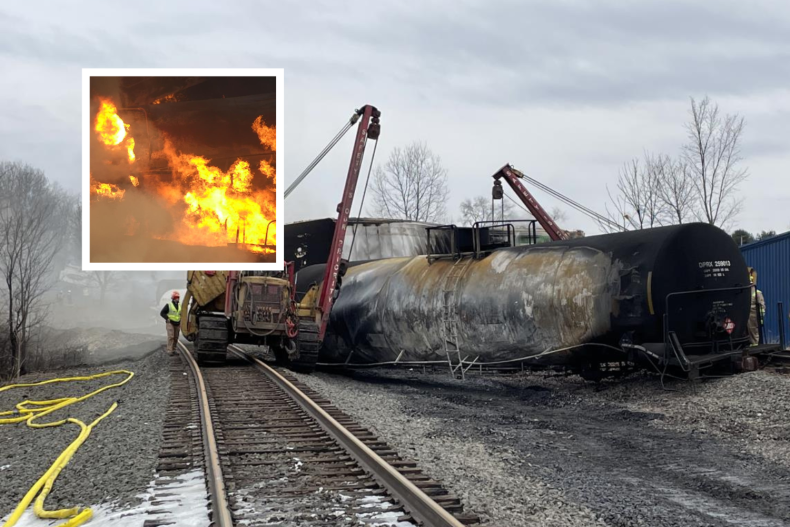Ohio Train Derailment Aftermath: Prolonged Presence Of Toxic Chemicals In Buildings

Table of Contents
Contamination Pathways: How Toxic Chemicals Spread
The release of toxic chemicals from the derailed train wasn't a contained event; it created multiple pathways for contamination to spread and persist within the environment and inside buildings.
Airborne Dispersion: A Widespread Threat
The initial explosion and subsequent burning of vinyl chloride sent plumes of toxic fumes into the air.
- Wind patterns: prevailing winds carried these fumes over a considerable distance, impacting a much wider area than initially anticipated.
- Atmospheric conditions: temperature inversions and low wind speeds could have trapped the chemicals closer to the ground, increasing exposure for residents.
- Persistence of chemicals in the air: some chemicals released have a relatively long atmospheric lifetime, meaning their presence in the air wasn't limited to the immediate aftermath of the derailment. Air quality monitoring studies, while initially focused on immediate aftermath, should be continued to determine the long-term impact.
Surface Contamination: A Silent Danger
The chemicals didn't simply remain airborne. Significant surface contamination occurred through various mechanisms.
- Runoff: rainfall and snowmelt likely carried chemicals into the surrounding soil and waterways, leading to wider environmental contamination.
- Deposition: fine particles containing toxic substances settled on surfaces such as soil, vegetation, and buildings, potentially leading to long-term exposure.
- Potential for leaching into groundwater: porous materials like soil could retain chemicals, slowly releasing them into groundwater over time, potentially contaminating drinking water sources. The types of surfaces most affected are porous materials like wood, concrete, and even some fabrics.
Indoor Contamination: A Hidden Hazard
The most concerning aspect is the potential for long-term indoor contamination. Toxic chemicals found their way into buildings through several routes.
- Open windows: during the initial release, open windows allowed chemicals to enter homes and other structures.
- HVAC systems: air conditioning and heating systems could have drawn contaminated air inside, distributing the chemicals throughout buildings.
- Porous building materials: chemicals could have absorbed into building materials like wood and drywall, releasing them slowly over time.
- Direct contact: people may have inadvertently tracked chemicals into their homes on their shoes or clothing. The persistence of these chemicals within buildings raises significant health concerns.
Health Concerns: Long-Term Exposure Risks
The health consequences of exposure to the Ohio train derailment toxic chemicals are a major source of anxiety for residents.
Acute Health Effects: Immediate Impacts
The immediate aftermath saw a range of acute health effects reported by residents.
- Respiratory issues: coughing, shortness of breath, and wheezing were common complaints.
- Headaches: many reported severe headaches, possibly related to chemical inhalation.
- Nausea: gastrointestinal distress was also reported, suggesting ingestion or inhalation of toxic substances.
- Skin irritation: some individuals experienced skin irritation and rashes from direct contact or airborne particles. Official reports from local health departments and hospitals should be carefully reviewed for a full picture of immediate impacts.
Chronic Health Effects: A Looming Threat
The more significant concern lies in the potential for long-term, chronic health problems from even low-level exposure to these chemicals.
- Cancer: many of the chemicals released are known or suspected carcinogens, raising fears about increased cancer rates in the affected area.
- Neurological disorders: exposure to certain chemicals can lead to neurological damage, affecting cognitive function and motor skills.
- Reproductive issues: some chemicals can negatively impact reproductive health, leading to fertility problems or birth defects. Independent and government-funded research into the long-term consequences is crucial for understanding the full health impact.
Vulnerable Populations: Increased Risk
Certain groups are at a significantly higher risk of experiencing adverse health effects.
- Children: children are especially vulnerable due to their developing immune systems and higher respiratory rates.
- Elderly: the elderly also have weaker immune systems and may be more susceptible to the toxic effects of the chemicals.
- Those with pre-existing conditions: individuals with respiratory or cardiovascular conditions are at increased risk of complications. Dedicated support and medical monitoring programs for these vulnerable groups are essential.
Remediation Efforts and Ongoing Monitoring
Addressing the contamination caused by the Ohio train derailment toxic chemicals requires a comprehensive and sustained effort.
Cleaning and Decontamination: A Herculean Task
Cleaning and decontaminating affected buildings is a complex and challenging process.
- Methods used: various techniques, such as specialized cleaning agents and HEPA filtration, are being used to remove chemicals from surfaces.
- Effectiveness: the effectiveness of these methods is variable, depending on the type of chemical, the material it has contaminated, and the depth of penetration.
- Difficulties in completely removing the chemicals: complete removal may be impossible in some cases, requiring long-term monitoring and management strategies.
Air and Water Testing: Essential for Public Health
Ongoing air and water testing is crucial to assess the extent and duration of contamination.
- Frequency of testing: regular testing is needed to track chemical levels and identify any potential hotspots.
- Reporting mechanisms: transparent and accessible reporting mechanisms are essential to keep the public informed about test results.
- Accessibility of results to residents: test results must be readily available to residents so they can make informed decisions about their health and safety.
Long-Term Monitoring Plan: A Necessary Investment
A comprehensive long-term monitoring plan is essential to ensure the long-term health and safety of the community.
- Funding: adequate funding is needed to support ongoing monitoring and remediation efforts.
- Agency oversight: effective oversight by relevant agencies is necessary to ensure that remediation efforts are thorough and effective.
- Community involvement: community participation is crucial in developing and implementing a long-term strategy.
Conclusion
The Ohio train derailment toxic chemicals pose a persistent and multifaceted threat to the affected community. The long-term effects of Ohio train derailment toxic chemicals remain a major concern, demanding continued vigilance and proactive action. The pervasive nature of the contamination, both in the environment and within buildings, underscores the need for sustained remediation and ongoing monitoring. We must ensure transparency from authorities regarding air and water quality testing results and advocate for a comprehensive long-term plan to address the Ohio train derailment chemical cleanup. Contact your elected officials, participate in community meetings, and stay informed about the latest developments. Your voice is vital in ensuring accountability and safeguarding the health and well-being of those affected by the Ohio train derailment.

Featured Posts
-
 Putin Ends Ukraine Truce Renewed Conflict Erupts
Apr 22, 2025
Putin Ends Ukraine Truce Renewed Conflict Erupts
Apr 22, 2025 -
 Assessing Pope Franciss Papacy The Conclaves Verdict
Apr 22, 2025
Assessing Pope Franciss Papacy The Conclaves Verdict
Apr 22, 2025 -
 Us Protests Against Trump Voices From Across The Nation
Apr 22, 2025
Us Protests Against Trump Voices From Across The Nation
Apr 22, 2025 -
 Googles Search Monopoly Another Court Battle With The Doj
Apr 22, 2025
Googles Search Monopoly Another Court Battle With The Doj
Apr 22, 2025 -
 Pope Francis Death Confirmed Pneumonia Complication At 88
Apr 22, 2025
Pope Francis Death Confirmed Pneumonia Complication At 88
Apr 22, 2025
